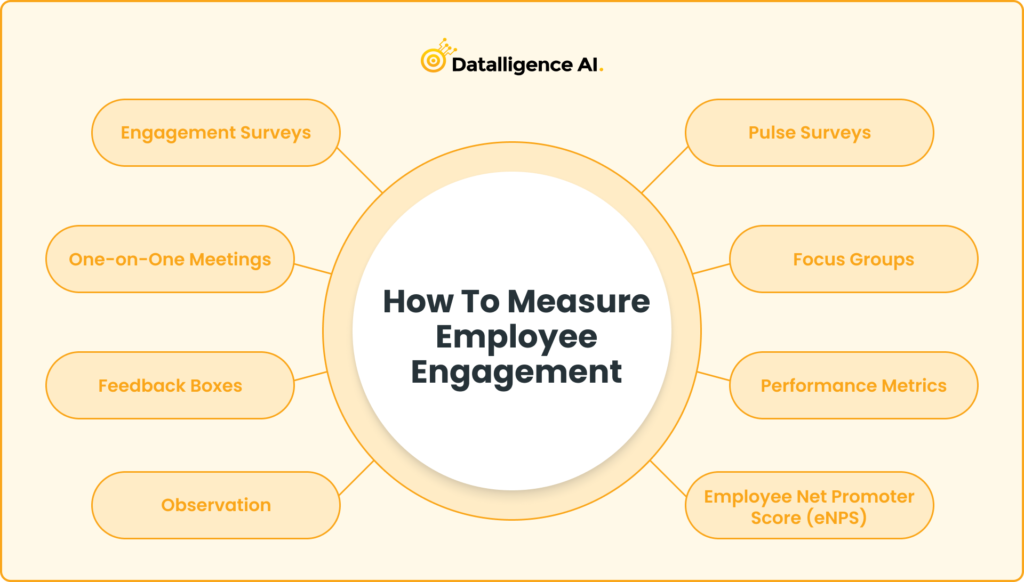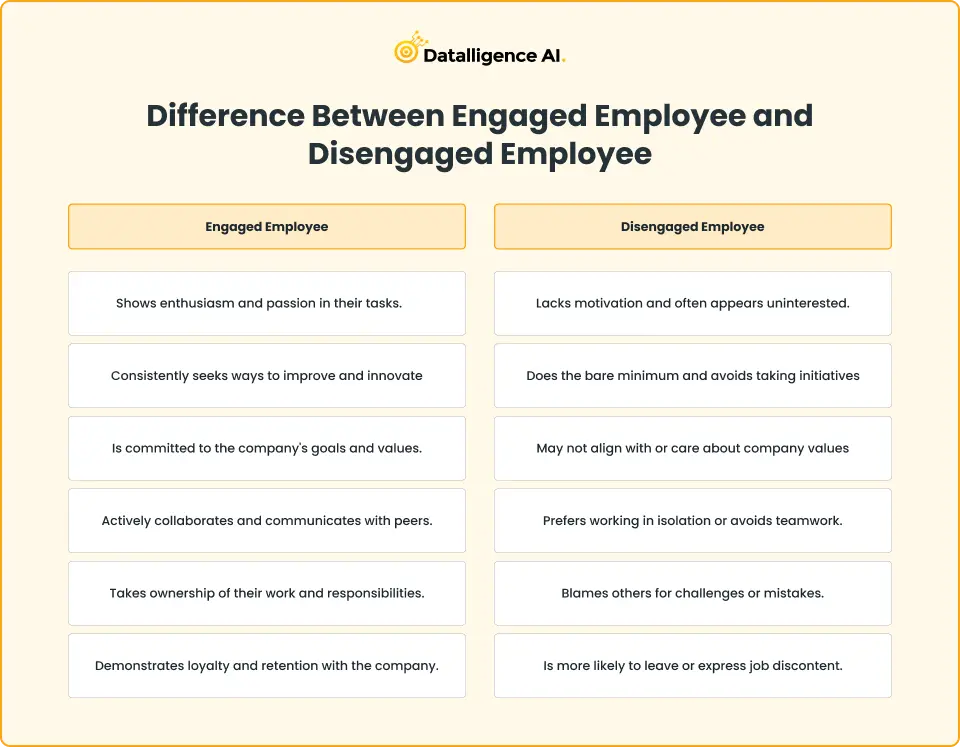Employee Engagement: What It Is and Why It’s Important
In the corporate arena, phrases like ’employee engagement’ aren’t just fleeting buzzwords but key concepts that industry leaders, HR experts, and managers emphasize regularly. So, what is employee engagement exactly? It’s far more than mere attendance at the workplace. It embodies deep involvement, genuine commitment, and a profound concern for both the role and the overarching organization. This article will explore why employee engagement is important, shedding light on the importance of employee engagement and its pivotal role in steering a company toward unparalleled success.
Your number one customers are your people. Look after employees first and then customers last.
– Ian Hutchinson
What is Employee Engagement
“To win in the marketplace, you must first win in the workplace.” – Doug Conant, former CEO of Campbell’s Soup.
At its core, employee engagement is about the emotional connection and commitment an employee feels toward their job, colleagues, and the company at large. It’s not merely about satisfaction or happiness; it’s the fire that drives an employee to go above and beyond, to be innovative, and to remain loyal to a company even during trying times.

Think of it as the difference between an employee who merely shows up for the paycheck and one who feels a deep-rooted purpose in their work and seeks to add value every single day.
Why is Employee Engagement So Important?
Employee engagement is paramount for numerous reasons, spanning from organizational health to competitive advantage. Engaged employees are not merely satisfied with their jobs; they are passionate and committed, and feel a profound connection to their work and company.
- First, when employees are engaged, they work harder and smarter, leading to better results. Secondly, engaged employees are more likely to stay with the company, reducing turnover costs.
- Thirdly, when employees care about their work, they bring new ideas to the table, helping the company grow and adapt.
- Fourthly, engaged employees often lead to satisfied customers, as they put in extra effort to meet customer needs.
- Lastly, a team of engaged employees creates a positive workplace atmosphere, making everyone’s job more enjoyable.
How To Measure Employee Engagement

Measuring employee engagement requires a combination of qualitative and quantitative approaches. Here’s how you can measure employee engagement along with some sample questions:
1. Engagement Surveys
Surveys can provide an overview of how employees feel about various aspects of their job and the company.
- On a scale from 1-10, how connected do you feel to your team and the company?
- Do you feel the company values your contributions?
- How meaningful is your work to you?
2. One-on-One Meetings
Regular personal check-ins can offer deeper insights into individual feelings and concerns.
Questions to ask:
- How do you feel about your current role and responsibilities?
- Are there areas where you feel we could improve as a team or company?
3. Feedback Boxes
These allow for anonymous feedback, which can provide unfiltered insights.
Possible Question:
- Share any concerns or suggestions you have for improving our work environment.
4. Observation
Managers can gauge engagement by watching behaviors, participating in meetings, and interacting with colleagues.
Questions to consider (for managers):
- Are employees participating actively in meetings?
- Do they collaborate well with team members?
5. Pulse Surveys
Short, frequent surveys to get real-time insights.
- How motivated do you feel this week?
- Do you have the resources you need to do your job effectively this month?
6. Focus Groups
Group discussions can provide collective insights.
Questions to initiate discussion:
- What changes can make our workplace better?
- Are there company policies that you feel hinder your work or well-being?
7. Performance Metrics
Regularly reviewing performance metrics can indirectly indicate engagement levels.
Questions to consider:
- Are employees meeting or exceeding their targets consistently?
- Is there a correlation between project success and team engagement?
8. Employee Net Promoter Score (eNPS)
A metric that measures employee loyalty.
Sample question:
- On a scale from 0-10, how likely are you to recommend this company as a great place to work?
Incorporating these methods and questions into your measurement strategy can provide a comprehensive view of employee engagement, allowing for targeted interventions and improvements.
Difference Between Engaged Employee and Disengaged Employee

4 Types of Employee Engagement

Employee engagement can be broadly categorized into four distinct types, which capture the range of attitudes and behaviors an employee may exhibit in relation to their job and the organization. Here are the four types:
1. Engaged and Committed
Employees who fall under this category are both passionate about their work and loyal to their company. They are the ideal type of employee, consistently going the extra mile and deeply invested in the company’s goals and values.
Traits: Enthusiastic, proactive, aligned with company values, takes initiative, demonstrates a sense of ownership.
2. Engaged but not Committed
These employees enjoy their daily tasks and roles but might not feel a strong sense of loyalty to the company or its goals. They might be open to new job opportunities elsewhere, even if they currently perform well in their role.
Traits: Task-focused, adaptable, collaborative, might lack company pride, open to external opportunities.
3. Neither Engaged nor Committed
Employees in this category are essentially “neutral.” They neither feel passionate about their work nor have a sense of loyalty to the company. They do what’s required but don’t go beyond that. They might be susceptible to becoming actively disengaged if there are negative shifts in their work environment.
Traits: Indifferent, reserved, does the bare minimum, non-participative in extra-curricular company activities, neutral in attitude.
4. Actively Disengaged
This group is the most concerning for organizations. Actively disengaged employees are not only unenthusiastic about their work but can also undermine company initiatives and spread negativity within the team.
Traits: Discontented, vocal about grievances, resistant to change, may foster negativity, detached from team and company goals.
Benefits Of Employee Engagement
Employee engagement isn’t just a buzzword in the corporate world; it’s a crucial element that can dictate a company’s success and the importance of employee engagement is becoming increasingly recognized in the business realm.When employees feel connected, valued, and passionate about their roles, it resonates in their performance and interactions.
The results of a highly engaged workforce are manifold. Here are the benefits:
- Engaged employees boost productivity with their dedication and efficiency.
- Higher engagement often translates to increased company profitability.
- Companies with engaged staff experience lower turnover rates.
- Engaged workers tend to have fewer absences, promoting consistent output.
- A workforce that’s engaged enhances the company’s reputation.
- Customer satisfaction rises when served by engaged employees.
- Innovation thrives in environments where employees are engaged and motivated.
- Engaged teams foster a happier, more cohesive work environment.
- Recruitment costs drop with higher engagement and employee retention.
- Decision-making aligns with company goals when employees are fully engaged.
In essence, fostering a culture of engagement isn’t just beneficial—it’s essential for any organization aiming for sustained growth and success.
Tips To Keep Your Employee Engaged
Maintaining employee engagement is pivotal for organizations aiming for success in today’s competitive landscape. Here are some effective tips to keep employees engaged:
- Foster open communication, encouraging employees to voice their ideas and concerns.
- Offer regular training and development opportunities to enhance skills.
- Recognize and reward outstanding performance, both publicly and privately.
- Provide clear career growth paths and advancement opportunities.
- Ensure a healthy work-life balance with flexible hours and remote work options.
- Create team-building activities that foster collaboration and camaraderie.
- Involve employees in decision-making processes, giving them a sense of ownership.
- Set clear expectations and provide regular feedback on performance.
- Invest in tools and technology that streamline tasks and reduce inefficiencies.
- Prioritize employee well-being with health programs and mental health support.
How Can Datalligence Help In Your Journey
As organizations recognize the importance of engagement, tools and platforms that facilitate this become invaluable.
Datalligence stands out in this realm. With its robust suite of features, it aids companies in aligning their objectives, tracking performance, and promoting a culture of continuous feedback and acknowledgment. It seamlessly blends performance management with engagement strategies, ensuring that employees don’t just align with company goals but are also actively invested in them. By using Datalligence, organizations get a streamlined path to fostering a culture of engagement and commitment.
Conclusion
Employee engagement is no longer a luxury or an afterthought. It’s a necessity. Engaged employees are the driving force behind a company’s success, pushing boundaries, driving innovation, and ensuring sustained growth. Tools like Datalligence further enhance this journey, ensuring that engagement is not just a goal but an embedded company culture. As we navigate the challenges of the modern corporate landscape, it’s clear: an engaged











